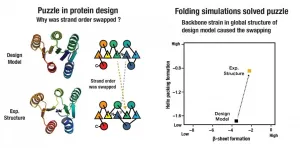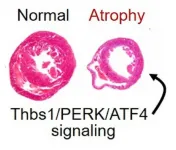(Press-News.org) COLUMBUS, Ohio - When the summer sun blazes on a hot city street, our first reaction is to flee to a shady spot protected by a building or tree.
A new study is the first to calculate exactly how much these shaded areas help lower the temperature and reduce the "urban heat island" effect.
Researchers created an intricate 3D digital model of a section of Columbus and determined what effect the shade of the buildings and trees in the area had on land surface temperatures over the course of one hour on one summer day.
"We can use the information from our model to formulate guidelines for community greening and tree planting efforts, and even where to locate buildings to maximize shading on other buildings and roadways," said Jean-Michel Guldmann, co-author of the study and professor emeritus of city and regional planning at The Ohio State University.
"This could have significant effects on temperatures at the street and neighborhood level."
For example, a simulation run by the researchers in one Columbus neighborhood found on a day with a high of 93.33 degrees Fahrenheit, the temperature could have been 4.87 degrees lower if the young trees already in that area were fully grown and 20 more fully grown trees had been planted.
Guldmann conducted the study with Yujin Park, who did the work as a doctoral student at Ohio State and is now an assistant professor of city and regional planning at Chung-Ang University in South Korea, and Desheng Liu, a professor of geography at Ohio State.
Their work was published online recently in the journal Computers, Environment and Urban Systems.
Researchers have long known about the urban heat island effect, in which buildings and roadways absorb more heat from the sun than rural landscapes, releasing it and increasing temperatures in cities.
One recent study found that in 60 U.S. cities, urban summer temperatures were 2.4 degrees F higher than rural temperatures - and Columbus was one of the top 10 cities with the most intense summer urban heat islands.
For this new study, Guldmann and his colleagues selected a nearly 14-square-mile area of northern Columbus that had a wide range of land uses, including single-family homes, apartment buildings, commercial and business complexes, industrial areas, recreational parks and natural areas. More than 25,000 buildings were in the study area.
The researchers created a 3D model of the study area using 2D land cover maps of Columbus, as well as LiDAR data collected by the city of Columbus from an airplane. LiDAR is a laser sensor that detects the shape of objects. Combining this data resulted in a 3D model showing the exact heights and widths of buildings and trees.
They then turned to computer software that calculated the shadows cast by each of the buildings and trees in the study area over the course of a one-hour period - 11 a.m. to noon - on Sept. 14, 2015.
In addition, the researchers had data on land surface temperatures in the study area for the same date and time. That data came from a NASA satellite that uses Thermal Infrared Sensors to measure land surface temperatures at a resolution of 30 by 30 meters (about 98 by 98 feet). That resulted in surface temperatures for 39,715 points in the study area.
With that data in hand, the researchers conducted a statistical analysis to determine precisely how the shade cast by buildings and trees affected surface temperatures on that September day.
Results showed that, as expected, buildings turned up the heat in the area, but that the shadows cast by them also had a significant cooling effect on temperatures, particularly if they shaded the rooftops of adjacent buildings.
The statistical model could precisely calculate those effects, both positive and negative. For example, a 1% increase in the area of a building led to surface temperature increases between 2.6% and 3% on average.
But an increase of 1% in the area of a shaded rooftop led to temperature decreases between 0.13% and 0.31% on average.
Shade on roadways and parking lots also significantly decreased temperatures.
"We learned that greater heat-mitigation effects can be obtained by maximizing the shade on building rooftops and roadways," Guldmann said.
Results also showed the importance of green spaces and water for lowering temperatures. Grassy areas, both shaded and exposed, showed significant heat-reducing effects. However, the impact of shaded grass was stronger than that of grass exposed to direct sunlight.
The volume of tree canopies and the area of water bodies also had significant cooling effects.
In the simulation run in the Columbus neighborhood, the researchers calculated that if the current trees there were fully grown, the temperature on a 93.33-degree F day would be 3.48 degrees lower (89.85 degrees).
But that's not all. The simulation showed that if the neighborhood had 20 more full-grown trees, the temperature would be another 1.39 degrees lower.
"We've long known that the shade of trees and buildings can provide cooling," Guldmann said.
"But now we can more precisely measure exactly what that effect will be in specific instances, which can help us make better design choices and greening strategies to mitigate the urban heat island effect."
INFORMATION:
Contact: Jean-Michel Guldmann, Guldmann.1@osu.edu
Written by Jeff Grabmeier, 614-292-8457; Grabmeier.1@osu.edu
A new tool to help conserve one of the UK's most threatened mammals has been released today, with the publication of the first high-quality reference genome for the European water vole. The genome was generated by scientists at the Wellcome Sanger Institute, in collaboration with animal conservation charity the Wildwood Trust, as part of the Darwin Tree of Life Project.
The genome, published today (24 June 2021) through Wellcome Open Research, is openly available as a reference for researchers seeking to assess water vole population genetics, better understand how the species has evolved and to manage reintroduction efforts.
The European water vole (Arvicola ...
A team from Japan and the United States has identified the design principles for creating large "ideal" proteins from scratch, paving the way for the design of proteins with new biochemical functions.
Their results appear June 24, 2021, in Nature Communications.
The team had previously developed principles to design small versions of what they call "ideal proteins," which are structures without internal energetic frustration.
Such proteins are typically designed with a molecular feature called beta strands, which serve a key structural role for the molecules. In ...
Our planet's strongest ocean current, which circulates around Antarctica, plays a major role in determining the transport of heat, salt and nutrients in the ocean. An international research team led by the Alfred Wegener Institute has now evaluated sediment samples from the Drake Passage. Their findings: during the last interglacial period, the water flowed more rapidly than it does today. This could be a blueprint for the future and have global consequences. For example, the Southern Ocean's capacity to absorb CO2 could decrease, which would in turn intensify climate change. The study has now been published in the journal Nature Communications.
The Antarctic Circumpolar Current (ACC) is the world's strongest ocean ...
Indonesia's volcanoes are among the world's most dangerous. Why? Through chemical analyses of tiny minerals in lava from Bali and Java, researchers from Uppsala University and elsewhere have found new clues. They now understand better how the Earth's mantle is composed in that particular region and how the magma changes before an eruption. The study is published in Nature Communications.
Frances Deegan, the study's first author and a researcher at Uppsala University's Department of Earth Sciences, summarises the findings.
"Magma is formed in the mantle, and the composition of the mantle under Indonesia used to be only partly known. ...
In many situations, heart muscle cells do not respond to external stresses in the same ways that skeletal muscle cells do. But under some conditions, heart and skeletal muscles can both waste away at fatally rapid rates, according to a new study led by experts at Cincinnati Children's.
The new findings, based on studies of mouse models, represent an important milestone in a long effort to prevent or even reverse cardiac atrophy, which can lead to fatal heart failure when the body loses large amounts of weight or experiences extended periods of weightlessness in space. Detailed findings were published online June 24, 2021, in Nature Communications.
"NASA is very interested in cardiac atrophy," says Jeffery Molkentin, PhD, Co-Director ...
UNIVERSITY OF TORONTO
TORONTO, ON - A new study from researchers at the University of Toronto found that 63% of Canadians with migraine headaches are able to flourish, despite the painful condition.
"This research provides a very hopeful message for individuals struggling with migraines, their families and health professionals," says lead author Esme Fuller-Thomson, who spent the last decade publishing on negative mental health outcomes associated with migraines, including suicide attempts, anxiety disorders and depression. "The findings of our study have contributed to a major paradigm shift for me. There are important lessons to be learned from those who are flourishing."
A migraine headache, which afflicts ...
A recent study finds states that exhibit higher levels of systemic racism also have pronounced racial disparities regarding access to health care. In short, the more racist a state was, the better access white people had - and the worse access Black people had.
"This study highlights the extent to which health care inequities are intertwined with other social inequities, such as employment and education," says Vanessa Volpe, corresponding author of the study and an assistant professor of psychology at North Carolina State University. "This helps explain why health inequities are so intractable. Tackling health care inequities will require us to address broader social systems that significantly benefit white people ...
"Red flag" gun laws--which allow law enforcement to temporarily remove firearms from a person at risk of harming themselves or others--are gaining attention at the state and federal levels, but are under scrutiny by legislators who deem them unconstitutional. A new analysis by legal scholars at NYU School of Global Public Health describes the state-by-state landscape for red flag legislation and how it may be an effective tool to reduce gun violence, while simultaneously protecting individuals' constitutional rights.
Gun violence is a significant public health problem in the U.S., with more than 38,000 people killed by firearms each year. Following several mass shootings this spring, President Biden urged ...
WHO Frank A. J. L. Scheer, PhD, MSc, Neuroscientist and Marta Garaulet, PhD, Visiting Scientist, both of the Division of Sleep and Circadian Disorders, Departments of Medicine and Neurology, Brigham and Women's Hospital. Drs. Scheer and Garaulet are co-corresponding authors of a new paper published in The FASEB Journal.
WHAT Eating milk chocolate every day may sound like a recipe for weight gain, but a new study of postmenopausal women has found that eating a concentrated amount of chocolate during a narrow window of time in the morning may help the body burn fat and decrease blood sugar levels.
To find out about the effects of eating milk chocolate at different times of day, researchers from the Brigham collaborated ...
Philadelphia, June 24, 2021 - Women with depression and other mood disorders are generally advised to continue taking antidepressant medications during pregnancy. The drugs are widely considered safe, but the effect of these medications on the unborn fetus has remained a topic of some concern. Now, researchers have found that maternal psychiatric conditions - but not the use of serotonin-selective reuptake inhibitors (SSRI) - increased the risk for autism spectrum disorder (ASD) and developmental delay (DD) in offspring.
The study appears in Biological Psychiatry, published by Elsevier.
Previous studies had found links between SSRI use and ASD in offspring, and ASD is associated with disrupted serotonergic pathways. But the question of whether ...


